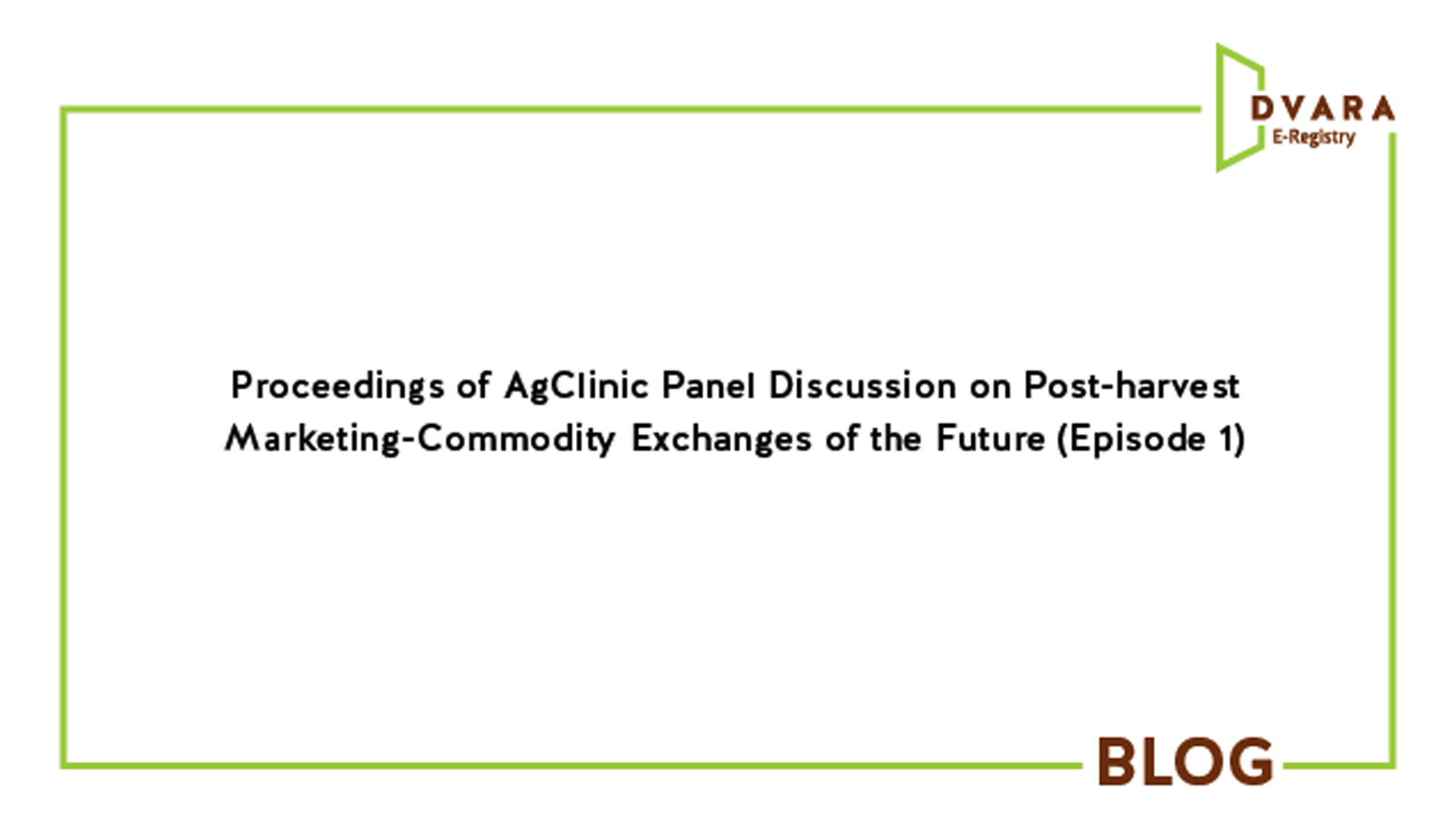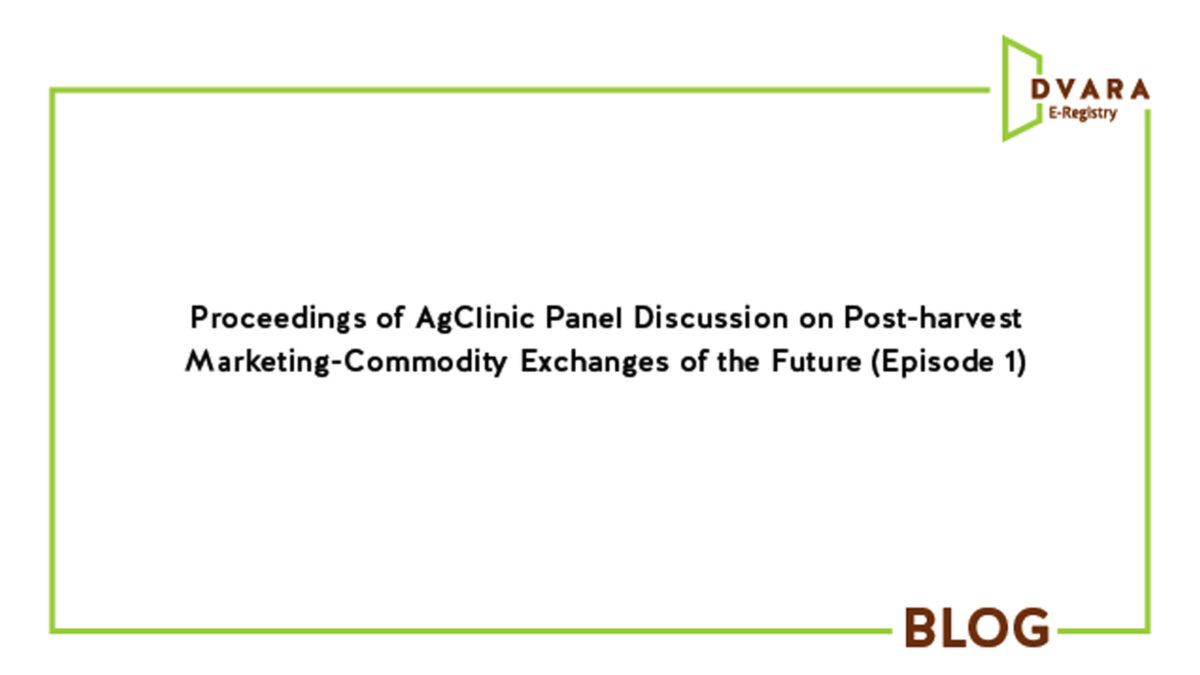
By Aparajita Singh, Dvara E-Registry and Abhijit Goswami, ThinkAg
The 5 historic agri-announcements are out now after decades of advocacy but what now, who will take this forward and how? To answer these questions, ThinkAg and Dvara Trust have curated a 3-episode series on Post Harvest Marketing. The first episode decodes Commodity Exchanges of the Future with a diverse and learned panel consisting of Mr. S.K. Mohanty (whole time member, SEBI), Mr. Vijay Kumar V (MD & CEO, NCDEX), Mr. Sanjay Kaul (Chairman, NCML), Mr. Jatin Singh (Founder & MD, Skymet), and Ms. Chetna Sinha (Founder & President, Mann Deshi Foundation).
The Farmers’ Produce Trade and Commerce (Promotion & Facilitation) increases the breadth of physical agri-market places which were restricted to APMCs till date. The Farmers (Empowerment & Protection) Agreement on Price Assurance and Farm Services provides for a farming agreement prior to production to help farmers sell directly to sponsors. The Essential Commodities (Amendment) will bring ample trade opportunities for manufacturers, processors and MNCs. They will also play an essential role in pumping additional liquidity in the market and buffering price fluctuations. The one lakh crore Agriculture Infrastructure Fund will unlock opportunities for trade and act as an enabler for warehouse receipt financing. At the heart of these are the Operational Guidelines for the Formation and Promotion of 10,000 FPOs which will give farmers an equal footing in a well-functioning market. The detailed research brief presented at the panel discussion summarizing these reforms, the landscape of Indian agri-markets and role of ag-techs in commodity exchanges in the post-reform era can be found here.
Removing the monopoly of APMC mandis, restrictions on storage, better infrastructure and norms dictating contract farming can bring a revolution in the agriculture sector. These reforms serve as a fertile ground for offering new and innovative models of operation to the erstwhile deprived and heavily regulated agricultural sector in India.
Simultaneously, we are cognizant that this is but the first step to ensuring a well-functioning agricultural market where all players are compensated fairly. The weakest link in this chain continues to be the farmer. It is only through empowering grassroot organizations like FPOs and ensuring they are indeed farmer owned can we bring about an agricultural revolution. Post-harvest marketing is pivotal to triggering these reforms and ensuring farmers get access to the best prices. While we have made significant progress on tackling production risk through crop insurance, price risk continues to haunt the agricultural sector.
Commodity exchanges and futures markets play an indispensable role in mitigating price risk for farmers. They also help inform better sowing decisions, promote access to markets, reduce transaction costs, tap into alternative sources of finance and prevent distress selling. The current status of agri-marketing in India is largely through traditional spot markets that are unorganized in nature and equipped with limited infrastructure. There are various costs of carrying out marketing activities from price discovery and transportation to searching for buyers and selling which we refer to as transaction costs. Over the last few years, there is a welcome shift from “farming to maximize yield” to “farming to maximize profit”.
As Mr. Mohanty (whole time member, SEBI) narrates, on the regulatory front, SEBI has taken several progressive steps to bring the commodity derivatives market at par with the equity market. To name a few, an exclusive clearing corporation was set up with the same set of innovation principles, counter party guarantee and risk management. SEBI had to overcome certain regulatory and legislative obstacles in order to launch ‘Option in Goods’. This is a giant step for farmers towards being able to factor in cost, tackle price fluctuations and claim profit where due. With the launch of AGRIDEX, India’s first return based agricultural futures index, Futures and Options can be traded both for agri & non-agri commodities.
In its effort to incentivize FPOs to trade on the platform and scale these efforts, SEBI has waived off the regulatory and turnover fee for FPOs. As a pilot, SEBI has advised NCDEX to retain the amount in a separate fund and subsidize the FPOs’ cost of transaction which includes transportation cost, grading cost and assaying cost. To further reduce the transaction costs incurred by FPOs in going through a broker for trading, SEBI wants to offer FPOs a limited broker-membership by bringing in a suitable regulatory amendment. Additionally, SEBI will enable FPOs to directly trade on the Exchange platform by simplifying the KYC norms.
Mr.Vijay Kumar V (MD & CEO, NCDEX), emphasises on the role of hedging price risk instead of speculative trading in the market. Internationally, most of the institutions in the sector have survived over the years as they have constantly hedged their risks. He also feels that NBFCs have been better touch points for farmers as compared to banks. Offering appropriate incentives structures in the form of discounted interest rates to institutions that lend or consumers who hedge would help deepen markets.
Mr.Sanjay Kaul (Chairman, NCML) envisions that the next few years will see a lot of collaboration between market players and policy makers. In a country like India with diversity in cropping patterns and commodities, the idea of having one centralized player like e-NAM may not be able to achieve the envisioned scale. Private innovations in marketing platforms cutting across commodities and geographies need to co-exist.
Mr. Jatin Singh (Founder & MD, Skymet) rightly notes that there is a major shift in narrative from states delivering goods to now these goods and services being delivered through private players. There is a need to provide services that are adaptable across different regions and demographics. A lot of these models are assisted to adapt to the limited financial literacy and awareness among the customer base.
Ms.Chetna Sinha (Founder & President, Mann Deshi Foundation) emphasises the responsibility of the industry in ensuring that the services and products being built are easy to use and accessible for farmers. If the industry wants farmers to get connected to the modern ecosystem, then the onus lies on the former to design suitable products. Currently, the operational issues while availing services like warehouse receipt financing in the form of getting lab test reports, assaying, and grading are too high for farmers who require immediate liquidity. If farmers see benefit, they will be willing to invest time and money in the commodity derivatives market, warehousing services, and paying for other services that add value to their business.
The highlight of the show was SEBI’s Innovation Sandbox which gives players working in the commodity derivatives market access to market data to test their innovations. ThinkAg and Dvara Trust plan to pilot a few concrete ideas on this platform. The proposed ideas include having an ERP equivalent interface for FPOs, price insurance (in case of horticultural crops), and weather indexed insurance. You can access the video of the proceedings here. To hear more about the roadmap ahead and opportunities to explore here, do tune in to the second episode on 6th October.
References
Agriculture Census Division, the Department of Agriculture, Cooperation and Farmers Welfare, Government of India (2019). Agriculture Census 2015-16
Chatterjee, T., Raghuanthan, R., & Gulati, A. (2019). Linking farmers to futures market in India. Working Paper 383, Indian Council for Research on International Economic Relations
Government of India (2020, February 8). Cabinet approves Central Sector Scheme of financing facility under Agriculture Infrastructure Fund. [Press Release]
Deana, S. (2019, September 3). Agtech Landscape: Tracking 1600+ Startups Innovating on the Farm and in the Supply Chain. Forbes.
Directorate of Economics &Statistics, Agricultural Statistics Division of the Department of Agriculture, Cooperation and Farmers Welfare, Government of India (2019). Agricultural Statistics At A Glance 2018.
Directorate of Economics &Statistics, Agricultural Statistics Division of the Department of Agriculture, Cooperation and Farmers Welfare, Government of India (2019, February 28). Second Advance Estimates of Production of Foodgrains for 2018-19.
Gulati, A. (2020, August 17th). Getting Agri-Markets Right. The Indian Express
Ministry of Agriculture & Farmer Welfare, Government of India (2020, February 4). Linking Farmers with Markets [Press Release]
Ministry of Finance, Government of India (2015). A National Market for Agricultural Commodities- Some Issues and the Way Forward. In Economic Survey 2014-15.
Nirmal, R. (2020, January 21). How many farmers are there in India? Government has no clue
Overview of Commodity Futures Exchanges and It’s Governance in India.
Pandey, K. (2018, August 28th). Poor post-harvest storage, transportation facilities to cost farmers dearly. Down To Earth.
P. Pingali et al. (2019), Transforming Food Systems for a Rising India, Palgrave Studies in Agricultural Economics and Food Policy, https://doi.org/10.1007/978-3-030-14409-8_8
Singh, A. and Shah, S. (2019, June 20). The Road Ahead for Farmer Producer Organisations in India. Dvara Research Blog.




